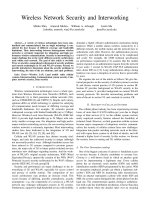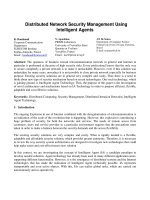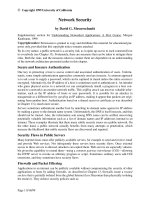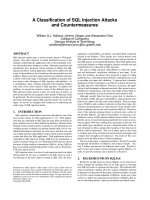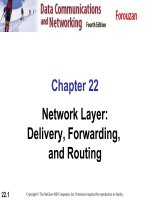Wireless Network Security: Vulnerabilities, Threats and Countermeasures ppt
Bạn đang xem bản rút gọn của tài liệu. Xem và tải ngay bản đầy đủ của tài liệu tại đây (100.14 KB, 10 trang )
International Journal of Multimedia and Ubiquitous Engineering
Vol. 3, No. 3, July, 2008
77
Wireless Network Security:
Vulnerabilities, Threats and Countermeasures
Min-kyu Choi
1)
, Rosslin John Robles
1)
, Chang-hwa Hong
2)
, Tai-hoon Kim
1)
School of Multimedia, Hannam University, Daejeon, Korea
, ,
Abstract
Wireless networking provides many advantages, but it also coupled with new security
threats and alters the organization’s overall information security risk profile. Although
implementation of technological solutions is the usual respond to wireless security threats
and vulnerabilities, wireless security is primarily a management issue. Effective management
of the threats associated with wireless technology requires a sound and thorough assessment
of risk given the environment and development of a plan to mitigate identified threats. We
present a framework to help managers understand and assess the various threats associated
with the use of wireless technology. We also discuss a number of available solutions for
countering those threats.
Keywords : Wireless Network, Wireless Security, Wireless Threats, Signal-Hiding
1. Introduction
Wireless networking presents many advantages Productivity improves because of
increased accessibility to information resources. Network configuration and
reconfiguration is easier, faster, and less expensive. However, wireless technology also
creates new threats and alters the existing information security risk profile. For
example, because communications takes place "through the air" using radio frequencies,
the risk of interception is greater than with wired networks. If the message is not
encrypted, or encrypted with a weak algorithm, the attacker can read it, thereby
compromising confidentiality. Although wireless networking alters the risks associated
with various threats to security, the overall security objectives remain the same as with
wired networks: preserving confidentiality, ensuring integrity, and maintaining
availability of the information and information systems. The objective of this paper is
to assist managers in making such decisions by providing them with a basic
understanding of the nature of the various threats associated with wireless networking
and available countermeasures.
The popularity of wireless Networks is a testament primarily to their convenience, cost
efficiency, and ease of integration with other networks and network components. The
majority of computers sold to consumers today come pre-equipped with all necessary wireless
Networks technology. The benefits of wireless Networks include: Convenience, Mobility,
Productivity, Deployment, Expandability and Cost.
International Journal of Multimedia and Ubiquitous Engineering
Vol. 3, No. 3, July, 2008
78
Wireless Network technology, while replete with the conveniences and advantages
described above has its share of downfalls. For a given networking situation, wireless
Networks may not be desirable for a number of reasons. Most of these have to do with the
inherent limitations of the technology. The disadvantages of using a wireless network are:
Security, Range, Reliability, and Speed.
Wireless Networks present a host of issues for network managers. Unauthorized access
points, broadcasted SSIDs, unknown stations, and spoofed MAC addresses are just a few of
the problems addressed in WLAN troubleshooting. Most network analysis vendors, such as
Network Instruments, Network General, and Fluke, offer WLAN troubleshooting tools or
functionalities as part of their product line.
2. Wireless Vulnerabilities, Threats and Countermeasures
The wireless networks consist of four basic components: The transmission of data
using radio frequencies; Access points that provide a connection to the organizational
network and/or the Client devices (laptops, PDAs, etc.); and Users. Each of these
components provides an avenue for attack that can result in the compromise of one or
more of the three fundamental security objectives of confidentiality, integrity, and
availability.
Fig. 1 Wireless networking components
2.1 Wireless Network Attacks
2.1.1 Accidental association
Unauthorized access to company wireless and wired networks can come from a
number of different methods and intents. One of these methods is referred to as
“accidental association”. When a user turns on a computer and it latches on to a
wireless access point from a neighboring company’s overlapping network, the user may
not even know that this has occurred. However, it is a security breach in that
proprietary company information is exposed and now there could exist a link from one
company to the other. This is especially true if the laptop is also hooked to a wired
network.
International Journal of Multimedia and Ubiquitous Engineering
Vol. 3, No. 3, July, 2008
79
2.1.2 Malicious association
“Malicious associations” are when wireless devices can be actively made by crackers
to connect to a company network through their cracking laptop instead of a company
access point (AP). These types of laptops are known as “soft APs” and are created when
a cracker runs some software that makes his/her wireless network card look like a
legitimate access point. Once the cracker has gained access, he/she can steal passwords,
launch attacks on the wired network, or plant trojans. Since wireless networks operate
at the Layer 2 level, Layer 3 protections such as network authentication and virtual
private networks (VPNs) offer no barrier. Wireless 802.1x authentications do help with
protection but are still vulnerable to cracking. The idea behind this type of attack may
not be to break into a VPN or other security measures. Most likely the cracker is just
trying to take over the client at the Layer 2 level.
2.1.3 Ad-hoc networks
Ad-hoc networks can pose a security threat. Ad-hoc networks are defined as peer-to-
peer networks between wireless computers that do not have an access point in between
them. While these types of networks usually have little protection, encryption methods
can be used to provide security.
2.1.4 Non-traditional networks
Non-traditional networks such as personal network Bluetooth devices are not safe
from cracking and should be regarded as a security risk. Even barcode readers,
handheld PDAs, and wireless printers and copiers should be secured. These non-
traditional networks can be easily overlooked by IT personnel who have narrowly
focused on laptops and access points.
2.1.5 Identity theft (MAC spoofing)
Identity theft (or MAC spoofing) occurs when a cracker is able to listen in on
network traffic and identify the MAC address of a computer with network privileges.
Most wireless systems allow some kind of MAC filtering to only allow authorized
computers with specific MAC IDs to gain access and utilize the network. However, a
number of programs exist that have network “sniffing” capabilities. Combine these
programs with other software that allow a computer to pretend it has any MAC address
that the cracker desires, and the cracker can easily get around that hurdle.
2.1.6 Man-in-the-middle attacks
A man-in-the-middle attacker entices computers to log into a computer which is set
up as a soft AP (Access Point). Once this is done, the hacker connects to a real access
point through another wireless card offering a steady flow of traffic through the
transparent hacking computer to the real network. The hacker can then sniff the traffic.
One type of man-in-the-middle attack relies on security faults in challenge and
handshake protocols to execute a “de-authentication attack”. This attack forces AP-
International Journal of Multimedia and Ubiquitous Engineering
Vol. 3, No. 3, July, 2008
80
connected computers to drop their connections and reconnect with the cracker’s soft AP.
Man-in-the-middle attacks are enhanced by software such as LANjack and AirJack,
which automate multiple steps of the process. What once required some skill can now
be done by script kiddies. Hotspots are particularly vulnerable to any attack since there
is little to no security on these networks.
2.1.7 Denial of service
A Denial-of-Service attack (DoS) occurs when an attacker continually bombards a
targeted AP (Access Point) or network with bogus requests, premature successful
connection messages, failure messages, and/or other commands. These cause legitimate
users to not be able to get on the network and may even cause the network to crash.
These attacks rely on the abuse of protocols such as the Extensible Authentication
Protocol (EAP).
2.1.8 Network injection
In a network injection attack, a cracker can make use of access points that are
exposed to non-filtered network traffic, specifically broadcasting network traffic such
as “Spanning Tree” (802.1D), OSPF, RIP, and HSRP. The cracker injects bogus
networking re-configuration commands that affect routers, switches, and intelligent
hubs. A whole network can be brought down in this manner and require rebooting or
even reprogramming of all intelligent networking devices.
2.1.9 Caffe Latte attack
The Caffe Latte attack is another way to defeat WEP. It is not necessary for the
attacker to be in the area of the network using this exploit. By using a process that
targets the Windows wireless stack, it is possible to obtain the WEP key from a remote
client. By sending a flood of encrypted ARP requests, the assailant takes advantage of
the shared key authentication and the message modification flaws in 802.11 WEP. The
attacker uses the ARP responses to obtain the WEP key in less than 6 minutes.
3. Securing Wireless Transmissions
The nature of wireless communications creates three basic threats: Interception,
Alteration and Disruption.
3.1 Protecting the Confidentiality of Wireless Transmissions
Two types of countermeasures exist for reducing the risk of eavesdropping on
wireless transmissions. The first involves methods for making it more difficult to locate
and intercept the wireless signals. The second involves the use of encryption to preserve
confidentiality even if the wireless signal is intercepted.
3.1.1 Signal-Hiding Techniques In order to intercept wireless transmissions, attackers first
need to identify and locate wireless networks. There are, however, a number of steps that
International Journal of Multimedia and Ubiquitous Engineering
Vol. 3, No. 3, July, 2008
81
organizations can take to make it more difficult to locate their wireless access points. The
easiest and least costly include the following: Turning offthe service set identifier (SSID)
broadcasting by wireless access points, Assign cryptic names to SSIDs, Reducing signal
strength to the lowest level that still provides requisite coverage or Locating wireless access
points in the interior of the building, away from windows and exterior walls. More effective,
but also more costly methods for reducing or hiding signals include: Using directional
antennas to constrain signal emanations within desired areas of coverage or Using of signal
emanation-shielding techniques, sometimes referred to as TEMPEST, 1 to block emanation of
wireless signals.
3.1.2 Encryption The best method for protecting the confidentiality of information
transmitted over wireless networks is to encrypt all wireless traffic. This is especially
important for organizations subject to regulations.
3.2 Preventing Alteration of Intercepted Communications
Interception and alteration of wireless transmissions represents a form of "man-in-
themiddle" attack. Two types of countermeasures can significantly reduce the risk of
such attacks: strong encryption and strong authentication of both devices and users.
3.3 Countermeasures to Reduce the Risk of Denial-of-Service Attacks
Wireless communications are also vulnerable to denial-of-service (DoS) attacks.
Organizations can take several steps to reduce the risk of such unintentional DoS
attacks. Careful site surveys can identify locations where signals from other devices
exist; the results of such surveys should be used when deciding where to locate wireless
access points. Regular periodic audits of wireless networking activity and performance
can identify problem areas; appropriate remedial actions may include removal of the
offending devices or measures to increase signal strength and coverage within the
problem area.
4. Securing Wireless Access Points
Insecure, poorly configured wireless access points can compromise confidentiality by
allowing unauthorized access to the network.
4.1 Countermeasures to Secure Wireless Access Points
Organizations can reduce the risk of unauthorized access to wireless networks by
taking these three steps:
1. Eliminating rogue access points;
2. Properly configuring all authorized access points; and
3. Using 802.1x to authenticate all devices.
International Journal of Multimedia and Ubiquitous Engineering
Vol. 3, No. 3, July, 2008
82
4.1.1 Eliminate Rogue Access Points
The best method for dealing with the threat of rogue access points is to use 802.1x on the
wired network to authenticate all devices that are plugged into the network. Using 802.1x will
prevent any unauthorized devices from connecting to the network.
4.1.2 Secure Configuration of Authorized Access Points
Organizations also need to ensure that all authorized wireless access points are securely
configured. It is especially important to change all default settings because they are
wellknown and can be exploited by attackers.
4.1.3 Use 802.1x to Authenticate all Devices
Strong authentication of all devices attempting to connect to the network can prevent rogue
access points and other unauthorized devices from becoming insecure backdoors. The 802.1x
protocol discussed earlier provides a means for strongly authenticating devices prior to
assigning them IP addresses.
5. Securing Wireless Client Devices
Two major threats to wireless client devices are (1) loss or theft, and (2)
compromise. Loss or theft of laptops and PDAs is a serious problem. laptops and PDAs
often store confidential and proprietary information. Consequently, loss or theft of the
devices may cause the organization to be in violation of privacy regulations involving
the disclosure of personal identifying information it has collected from third parties.
Another threat to wireless client devices is that they can be compromised so that an
attacker can access sensitive information stored on the device or use it to obtain
unauthorized access to other system resources.
6. Securing Wireless Networks
6.1 Use of Encryption
The most effective way to secure your wireless network from intruders is to encrypt, or
scramble, communications over the network. Most wireless routers, access points, and base
stations have a built-in encryption mechanism. If your wireless router doesn’t have an
encryption feature, consider getting one that does. Manufacturers often deliver wireless
routers with the encryption feature turned off. You must turn it on.
International Journal of Multimedia and Ubiquitous Engineering
Vol. 3, No. 3, July, 2008
83
6.2 Use anti-virus and anti-spyware software, and a firewall
Computers on a wireless network need the same protections as any computer connected to
the Internet. Install anti-virus and anti-spyware software, and keep them up-to-date. If your
firewall was shipped in the “off” mode, turn it on.
6.3 Turn off identifier broadcasting
Most wireless routers have a mechanism called identifier broadcasting. It sends out a
signal to any device in the vicinity announcing its presence. You don’t need to broadcast this
information if the person using the network already knows it is there. Hackers can use
identifier broadcasting to home in on vulnerable wireless networks. Disable the identifier
broadcasting mechanism if your wireless router allows it.
6.4 Change the identifier on your router from the default
The identifier for your router is likely to be a standard, default ID assigned by the
manufacturer to all hardware of that model. Even if your router is not broadcasting its
identifier to the world, hackers know the default IDs and can use them to try to access your
network. Change your identifier to something only you know, and remember to configure the
same unique ID into your wireless router and your computer so they can communicate. Use a
password that’s at least 10 characters long: The longer your password, the harder it is for
hackers to break.
6.5 Change your router’s pre-set password for administration
The manufacturer of your wireless router probably assigned it a standard default password
that allows you to set up and operate the router. Hackers know these default passwords, so
change it to something only you know. The longer the password, the tougher it is to crack.
6.6 Allow only specific computers to access your wireless network
Every computer that is able to communicate with a network is assigned its own unique
Media Access Control (MAC) address. Wireless routers usually have a mechanism to allow
only devices with particular MAC addresses access to the network. Some hackers have
mimicked MAC addresses, so don’t rely on this step alone.
6.7 Turn off your wireless network when you know you won’t use it
Hackers cannot access a wireless router when it is shut down. If you turn the router off
when you’re not using it, you limit the amount of time that it is susceptible to a hack.
6.8 Don’t assume that public “hot spots” are secure
International Journal of Multimedia and Ubiquitous Engineering
Vol. 3, No. 3, July, 2008
84
Many cafés, hotels, airports, and other public establishments offer wireless networks for
their customers’ use.
7. Training and Educating Users
Notice that Figure 1 also includes users as the fourth basic component of wireless
networking. As is the case with wired security, users are the key component to wireless
networking security. Indeed, the importance of training and educating users about
secure wireless behavior cannot be overstated. To be effective, user training and
education needs to be repeated periodically.
8. Network Auditing
Wireless network auditing is an important part of WLAN security policy. The network
needs to be regularly audited for rouge hardware. In this method the network is scanned and
mapped for all access points and WLAN nodes. Then this is compared with previous network
map. Commonly available network mapping tools like netstumbler and wavelan-tool can be
used to do this. Specialized tools such as Airsnort can be used for WEP cracking and auditing
the network for weak keys, key reuse and WEP security settings. These methods include the
same tests as those carried out by hackers for breaking into the network.
9. Conclusion
Wireless networking provides numerous opportunities to increase productivity and
cut costs. It also alters an organization’s overall computer security risk profile.
Although it is impossible to totally eliminate all risks associated with wireless
networking, it is possible to achieve a reasonable level of overall security by adopting a
systematic approach to assessing and managing risk. This paper discussed the threats
and vulnerabilities associated with each of the three basic technology components of
wireless networks (clients, access points, and the transmission medium) and described
various commonly available countermeasures that could be used to mitigate those risks.
It also stressed the importance of training and educating users in safe wireless
networking procedures.
References
[1] Graham, E., Steinbart, P.J. (2006) Wireless Security
[2] Cisco. (2004). Dictionary attack on Cisco LEAP vulnerability, Revision 2.1, July 19.
[3] CSI. (2004). CSI/FBI Computer Crime and Security Survey.
[4] Hopper, D. I.(2002). Secret Service agents probe wireless networks in Washington.
International Journal of Multimedia and Ubiquitous Engineering
Vol. 3, No. 3, July, 2008
85
[5] Kelley, D. (2003). The X factor: 802.1x may be just what you need to stop intruders
from accessing your network. Information Security, 6(8), 60-69.
[6] Kennedy, S. (2004). Best practices for wireless network security. Information Systems
Control Journal (3).
[7] McDougall, P. (2004, March 25). Laptop theft puts GMAC customers’data at risk.
Information Week Security Pipeline.
[8] Nokia. (2003). Man-in-the-middle attacks in tunneled authentication protocols.
[9] Paladugu, V., Cherukuru, N., & Pandula, S. (2001). Comparison of security protocols
for wireless communications.
[10] Slashdot. (2002, August 18). Wardriving from 1500ft Up.
[11] Stoneburner, G., Goguen, A., & Feringa, A. (2002, July). Risk management guide for
information technology systems. NIST Special Publication 800-30.
[12] Wailgum, T. (2004, September 15). Living in wireless denial. CIO Magazine.
Acknowledgement
This work was supported by a grant from Security Engineering Research Center of
Ministry of Knowledge Economy, Korea
International Journal of Multimedia and Ubiquitous Engineering
Vol. 3, No. 3, July, 2008
86
Authors
Min-kyu Choi
He is currently a Multimedia Student at Hannam University, Korea.
His research interests are Network Security and Software Security.
Rosslin John Robles
He received his B.S. in Information Technology from Western
Visayas College of Science and Technology, Philippines. He is
currently a Multimedia integrate Masters-Ph.D. Student at Hannam
University, Korea. His research interests are Software Engineering
and IT Security.
Tai-hoon Kim
He received B.E., M.E., and Ph.D. degrees from Sungkyunkwan
University. Now he is a professor, School of Information &
Multimedia, Hannam University, Korea. His main research areas
are security engineering for IT products, IT systems, development
processes, and operational environments.

